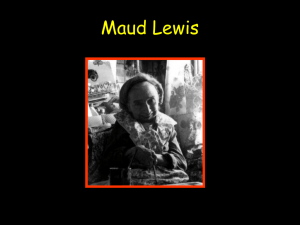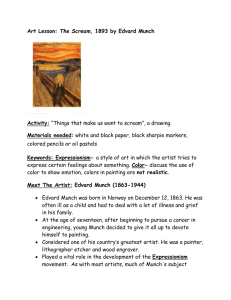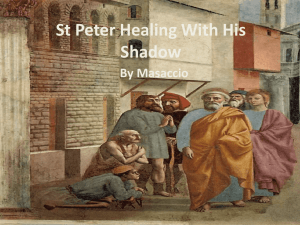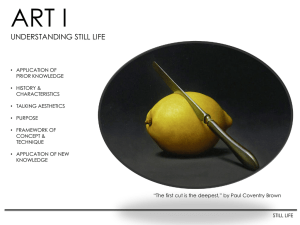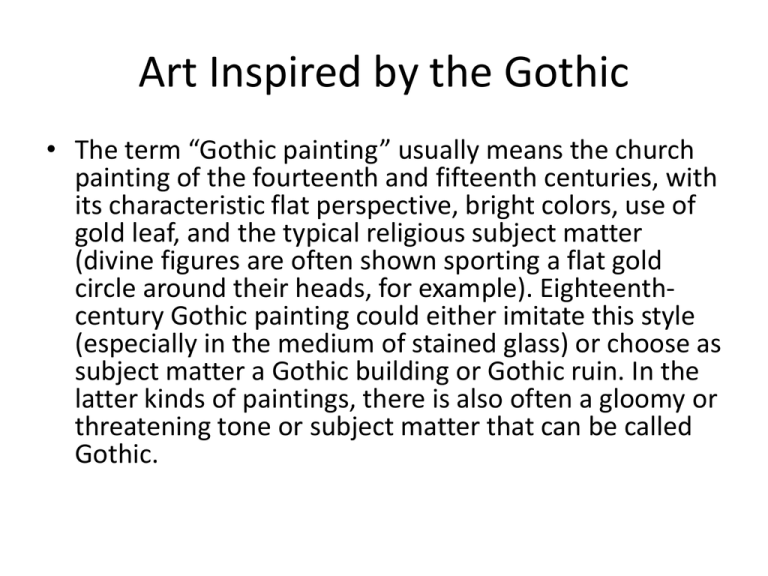
Art Inspired by the Gothic
• The term “Gothic painting” usually means the church
painting of the fourteenth and fifteenth centuries, with
its characteristic flat perspective, bright colors, use of
gold leaf, and the typical religious subject matter
(divine figures are often shown sporting a flat gold
circle around their heads, for example). Eighteenthcentury Gothic painting could either imitate this style
(especially in the medium of stained glass) or choose as
subject matter a Gothic building or Gothic ruin. In the
latter kinds of paintings, there is also often a gloomy or
threatening tone or subject matter that can be called
Gothic.
American Gothic by Grant Wood
American Gothic is a painting by Grant Wood, in the collection of the
Art Institute of Chicago. Wood's inspiration came from what is now
known as the American Gothic House, and a decision to paint the
house along with "the kind of people I fancied should live in that
house."[1] The painting shows a farmer standing beside his spinster
daughter.[2] The figures were modeled by the artist's sister and their
dentist. The woman is dressed in a colonial print apron evoking 19thcentury Americana, and the couple are in the traditional roles of men
and women, the man's pitchfork symbolizing hard labor, and the
flowers over the woman's right shoulder suggesting domesticity.
It is one of the most familiar images in 20th-century American art, and
one of the most parodied artworks within American popular culture.
Art Institute of Chicago
The Nightmare by Henry Fuseli
The Nightmare is a 1781 oil painting by Anglo-Swiss artist Henry Fuseli
(1741–1825). Since its creation, it has remained Fuseli's best-known
work. With its first exhibition in 1782 at the Royal Academy of London,
the image became famous; an engraved version was widely distributed
and the painting was parodied in political satire. Due to its fame, Fuseli
painted at least three other versions of the painting.
Interpretation of The Nightmare have varied widely. The canvas seems
to portray simultaneously a dreaming woman and the content of her
nightmare. The incubus and the horse's head refer to contemporary
belief and folklore about nightmares, but have been ascribed more
specific meanings by some theorists.[1] Contemporary critics were
taken aback by the overt sexuality of the painting, which has since
been interpreted by some scholars as anticipating Freudian ideas
about the unconscious.
The Scream by Edvard Munch
•
The Scream (Norwegian: Skrik) is the popular name given to each of four versions of a composition,
created as both paintings and pastels, by the Expressionist artist Edvard Munch between 1893 and
1910. Der Schrei der Natur (The Scream of Nature) is the title Munch gave to these works, all of
which show a figure with an agonized expression against a landscape with a tumultuous orange sky.
The landscape in the background is the Oslofjord, viewed from Ekeberg, Oslo, Norway.
•
Edvard Munch created the four versions in various media. The National Gallery, Oslo, holds one of
two painted versions (1893, shown at right). The Munch Museum holds the other painted version
(1910, see gallery) and a pastel version from 1893. These three versions have not traveled for
years.[1]
•
The fourth version (pastel, 1895) was sold for $119,922,600 at Sotheby's Impressionist and Modern
art auction on 2 May 2012 to financier Leon Black,[2][3] the highest nominal price paid for a painting
at auction.[4] The painting is on display in the Museum of Modern Art in New York for six months
from October 2012 to March 2013.
•
Also in 1895, Munch created a lithograph stone of the image. Of the lithograph prints produced by
Munch, several examples survive.[5] Only approximately four dozen prints were made before the
original stone was resurfaced by the printer in Munch's absence.[6]
•
The Scream has been the target of several high-profile art thefts. In 1994, the version in the
National Gallery was stolen. It was recovered several months later. In 2004, both The Scream and
Madonna were stolen from the Munch Museum, and recovered two years later.
Oslo, Norway- Munch Museum
Fishermen at Sea by J.M.W. Turner
The first oil painting Turner exhibited at the Royal Academy,
this is a moonlit scene in the tradition of Horace Vernet, Philip
de Loutherbourg and Joseph Wright of Derby. These painters
were largely responsible for fuelling the 18th-century vogue
for nocturnal subjects. The sense of the overwhelming power
of nature is a key theme of the Sublime. The potency of the
moonlight contrasts with the delicate vulnerability of the
flickering lantern, emphasising nature’s power over mankind
and the fishermen’s fate in particular. The jagged silhouettes
on the left are the treacherous rocks called ‘the Needles’ off
the Isle of Wight.
Tate Modern- London
Gothic by Jackson Pollock
Jackson Pollock said regarding his art "When I am in a painting, I'm not aware of what
I'm doing. It is only after a sort of 'get acquainted' period that I see what I have been
about. I have no fears about making changes, destroying the image, etc, because the
painting has a life of its own. I try to let it come through. It is only when I lose contact
with the painting that the result is a mess. Otherwise there is pure harmony, an easy
give and take, and the painting comes out well." He also said, "The method of painting
is the natural growth out of a need. I want to express my feelings rather than illustrate
them." Describing his painting on the floor "On the floor I am more at ease, I feel
nearer, more a part of the painting, since this way I can walk around it, work from the
four sides and literally be in the painting." Agreed upon by many critics as one of the
greatest painters in the United States in the 20th century, Jackson Pollock would
devise a new art, free from brushes and easels, where his body and mind worked to
produce an abstract image. It was his early studies in art that led him to his discovery
and his influence can still be seen in America’s avant-garde art movements. Jackson
Pollock was the first American abstract painter to be taken seriously in Europe. It was
not until 1947 that Pollock began his "action" paintings, influenced by Surrealist ideas
of "psychic automatism" (direct expression of the unconscious). Pollock would fix his
canvas to the floor and drip paint from a can using a variety of objects to manipulate
the paint.
MoMA




